Phase 5
Let’s now deal with the series that have been created since 2013, giving some representative examples.
At the beginning of phase 5 in 2013, I first tied up with phase 4. I took up again the principle of the layer pictures which to my mind still worked quite well. Though, there were variations that slightly modified the accents and focuses of this strategy. Equally, I continued to work with hand- or typewritten excerpts that I had made as a student.
The following example was created in spring 2013, as the second piece of that year. It consists of two components: first, there is a DIN A0 photocopy of a handwritten excerpt that refers to Hegel’s aesthetics. Glued onto chipboard, another photocopy of this sheet serves as a basis for the following artistic manipulation – component number 2.
The “Reading pictures”
What about the series that are connected to your scientific activity at university?
I usually divide them into to groups of works: Talking about series 1, I use the term “reading pictures” because it contains scientific texts that were part of my lectures. Series 2, which is entitled Coping with the past, refers to my experiences in the focus Mythos, Ideologie und Methoden.
How do you proceed in series 1?
My lectures used to follow a specific scheme, whatever the topic was: To start with, I gave a speech about 20 to 30 minutes, which I then summed up in a two page outline of the most essential points. I gave my students some minutes to ask questions before moving on to a second speech part. I always brought a prepared and formulated conclusion with me that I used to project on the wall. Some pictorial objects use one of these summarizing texts as a basis. Similarly to phase 4, my artworks of that time do not deal with the content of my teaching and research – the summaries are rather some kind of raw material for my intuitive and improvisational way of working.
The first pictorial object from phase 4, which was created in spring 2013, is a good example for this strategy.
Yes. Similar to the last example, this object is composed of two components. The first component is a summary text from my lecture on myth research. Glued onto chipboard, a photocopy of this sheet serves as a basis for the following artistic manipulation which forms the second component. Again, both copies are printed on DIN A0 format.
Some words and constituents have been extracted from the text by painting over the rest of it, either completely or in parts. If the summary text eventually gets reduced to “The thinking of … green ants … exemplary”, this is a way for me to play upon the text poetically and with a certain ironic twist, thus stimulating the imagination of the viewer, whose gaze wanders from the initial text to the picture and back (just as it does, even though differently, in some objects from phase 2)[15].
Pictorial objects of this kind seem to establish a link to your scientific activity in a freer, purely artistic manner.
Exactly. I will give two more examples from this series:
In what does your working strategy differ from the one of a scientist/artist pursuing a science-related artistic agenda – such as for example BioArt?
Such an artist would try to represent certain contents of the chosen lecture visually or interpret them with the means of visual art. By contrast, I do not explicitly react to the given research findings nor to the respective theories and methods. My reading pictures are based on the poetical play with certain words and syntactical components from the summary text, which engenders new alienated constellations of sense.[16] However, the source text constitutes an essential part of the work, for in an exhibition it would be shown in an equal size just next to the actual pictorial object. This makes sure that the recipient can recognize certain contents of the chosen lecture and see, by comparing the original and its artistic adaptation, what has become of them. Sometimes I choose the remaining words and components before starting the creative processing, sometimes the selection is part of the latter.
Coping with the past
Ok for series 1. How did the series Coping with the past come into being?
At the end of an academic service, you have to – among other things – move out of your office. During the cleaning I found a bigger amount of writing paper with the logo of the focus as well as templates for lecture announcements, which I had used above all in the 1990s.[17] Now I used these materials as patterns for my 2014 series Coping with the past, which helped me to reflect – again in an intuitive and improvising way – upon the 25 year history of the study focus Mythos, Ideologie und Methoden. Series 2 consists of 39 artworks on the whole, mostly manipulations of the letter paper in DIN A4 format, but there are also four bigger works. For this series I frequently used – as in some pictorial objects – materials that had been part of my daily life as a scientist, which obviously included a lot of paperwork: stickers, post-it notes, Tipp-Ex and so on.
I will give you these examples:
Recycling Leftovers
In order to round off our interview, could you please tell us something about a series which does not have any direct link to your scientific activity?
In the years 2015 and 2016 I created the extensive series 3, which comprises several smaller series. It is called Recycling Leftovers and it has quite a funny background. During an open studio day in spring 2015, I met w/k editor and artist Meral Alma, who has, like me, an atelier at Werstener Kulturbunker. When I casually mentioned some works from the 1990s in which I had used fragments of the old floor covering from the storeroom of my parents’ house, she remembered that after renovating her atelier, she had had some leftovers, too. She asked me whether I wanted to have them and I thought: “Let’s give it a try”. During the following period, I created quite a few pictorial objects and works on paper in which I used parts of the different floor coverings.
I show you four works: three on chipboard, one on paper.
Having already talked about how you name the specific working strategies of the different phases, I would like to know how you call what you do in phase 5.
Speaking about phase 4, I told you about the connection between informalism and minimal construction, that is about informal construction. This has turned out to be some kind of general artistic program which I remain true to even in phase 5. Yet, I obviously try to invent new concepts of seriality. As a consequence, some of the series created during phase 5 are very different from what I did in phase 4.
We will present some more younger series as well as current works in the second part of our interview.
Exactly, this interview is to be continued in 2017.
Translation: Laura Strack.
Picture above article: Peter Tepe: Großer Brief mit Streifen (2013). Photo: Tanja Semlow.
[1] The history of this institution is exhaustively described in P. Tepe: 25 Jahre Schwerpunkt Mythos, Ideologie und Methoden … und kein Ende. In: Mythos-Magazin (2013), see http://www.mythos-magazin.de/geschichtedesschwerpunkts/pt_25Jahre.pdf. Additional information is provided by the documentary, such as my farewell lecture: 25 Jahre Schwerpunkt Mythos, Ideologie und Methoden …und kein Ende – Dokumentation 1. In: Mythos-Magazin (2014), see www.mythos-magazin.de/geschichtedesschwerpunkts /pt_25Jahre-Dokumentation1.pdf, S. 7–17.
[2] Cf. P. Tepe: 25 Jahre Schwerpunkt Mythos, Ideologie und Methoden … und kein Ende. In: Mythos-Magazin (2013).
[3] Mythologica. Düsseldorfer Jahrbuch für interdisziplinäre Mythosforschung (8 volumes 1993-2002 ed. Die blaue Eule, Essen). Mythos. Fächerübergreifendes Forum für Mythosforschung (4 volumes 2004-2016 ed. Königshausen & Neumann, Würzburg). Mythos-Magazin. Online-Journal für die Bereich Erklärende Hermeneutik, Ideologieforschung und Mythosforschung (numerous issues since 2005, available online: www.mythos-magazin.de).
[4] Some of them have been published in the school newspaper neue realität of the Ernst-Moritz-Arndt-Gymnasium.
[5] Cf. P. Tepe: 25 Jahre Schwerpunkt Mythos, Ideologie und Methoden … und kein Ende. In: Mythos-Magazin (2013), chapter 15: “Erprobung neuer Veranstaltungsformen”.
[6] For reasons of simplification, I will use the term “informal” as a generic term for the quoted artistic currents.
[7] The second speech of my farewell lecture contains visual examples and further explanation. Cf. P. Tepe: Die andere Seite. In: P. Tepe: 25 Jahre Schwerpunkt Mythos, Ideologie und Methoden … und kein Ende – Dokumentation 1, S. 19–24 and P. Tepe: Bildpräsentation zum Vortrag Die andere Seite. In: Mythos-Magazin (2014), see www.mythos-magazin.de/geschichtedesschwerpunkts/pt_bildpraesentation.pdf.
[8] These artworks that used to be stored in the hallway in front of Mr. Götz’s class will have been removed by the janitor, but some photos still exist.
[9] The speech Die andere Seite contains visual examples for the artworks dealt with in this interview.
[10] P. Tepe: Künstlerische Konzeption. In: C. Scholl / P. Tepe: Multimedialer Aktionsabend. Dreieck Kunst – Philosophie– Musik. Setzen – Zusammen – Setzen. Düsseldorf 1992.
[11] P. Tepe: Postmoderne/Poststrukturalismus. Wien, 1992.
[12] P. Tepe: Mythos & Literatur. Aufbau einer literaturwissenschaftlichen Mythosforschung. Würzburg, 2001.
[13] P. Tepe / May H.: Mythisches, Allzumythisches. Theater um alte und neue Mythen 1. Ratingen, 1995. Cf. P. Tepe: 25 Jahre Schwerpunkt Mythos, Ideologie und Methoden … und kein Ende. In: Mythos-Magazin (2013), chapters 15.2: “Theatralische Vorlesung: Vorlesung in Theaterform” and 15.3: “Dialogische Vorlesung”.
[14] Cf.: Welbers, U. / Preuss, M. (Ed.): Die reformierte Germanistik. Dokumentation zur Düsseldorfer Studienreform. Düsseldorf, 2000.
[15] See the visual examples in P. Tepe: Die andere Seite. In: P. Tepe: 25 Jahre Schwerpunkt Mythos, Ideologie und Methoden … und kein Ende – Dokumentation 1, S. 19–24.
[16] The pictorial object spürbar sagen from phase 4, shown above, can be considered a forerunner.
[17] Among other things, the letter paper indicates who was working for me in those days as a research assistant. Professor Herbert Anton had allocated me not only this job position but also, for many years, several positions for undergraduate assistants.
How to cite this article
Peter Tepe (2016): Border Crosser between Science and Visual Arts. w/k–Between Science & Art Journal. https://doi.org/10.55597/e1610
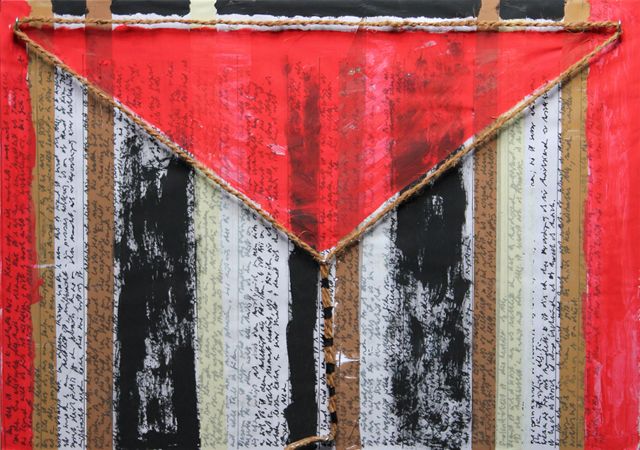
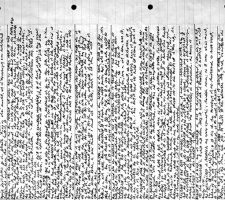

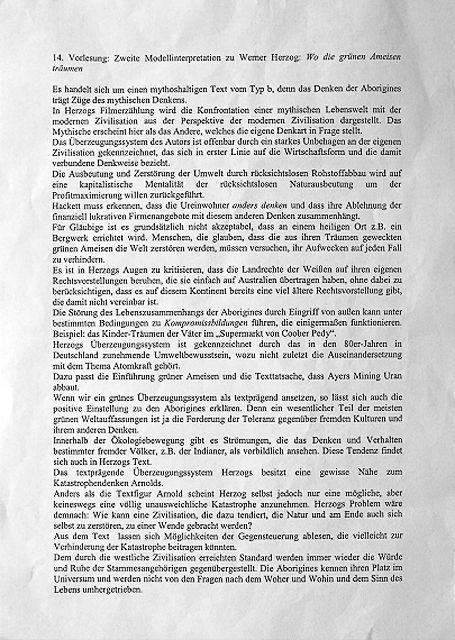



![Aus dem Fazit einer Vorlesung [From the Conclusion of a Lecture] (nach 2000). Photo: Tanja Semlow.](https://between-science-and-art.com/wp-content/uploads/sites/4/2016/10/TEPE-Grenzgaenger-Sphaere-Vorlage-EN.jpg)
![Peter Tepe: …die phantastische Sphäre ist nicht so unromantisch [...The fantastic Sphere is not that Unromantic] (2014). Foto: Tanja Semlow.](https://between-science-and-art.com/wp-content/uploads/sites/4/2016/10/TEPE-Grenzgaenger-Sphaere-EN.jpg)
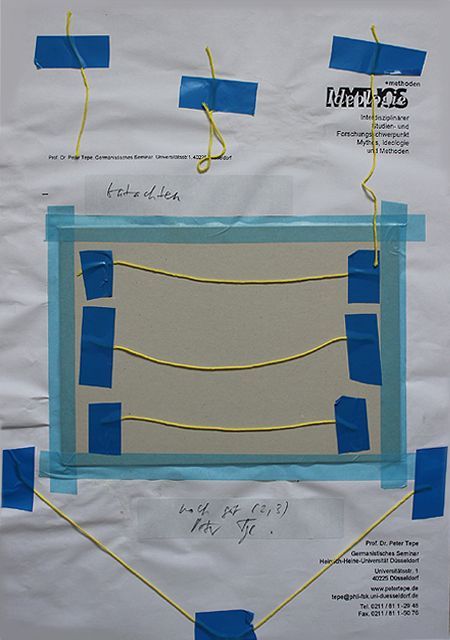

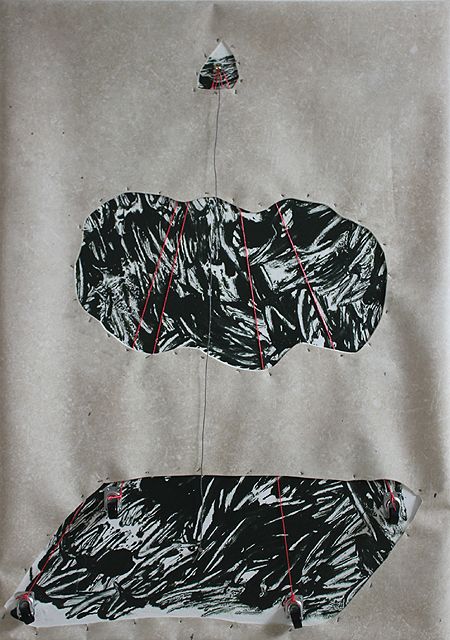
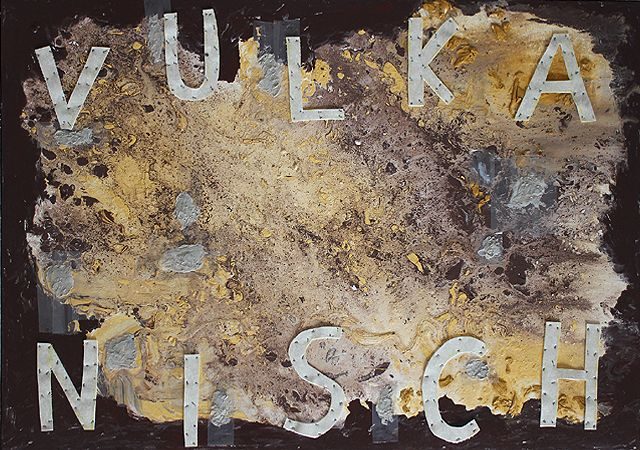
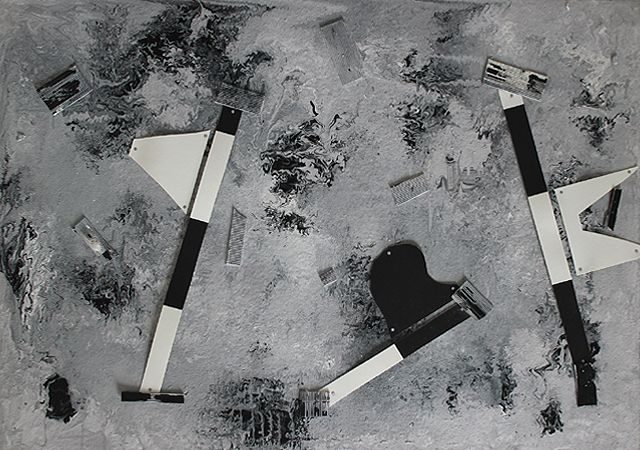


Be First to Comment